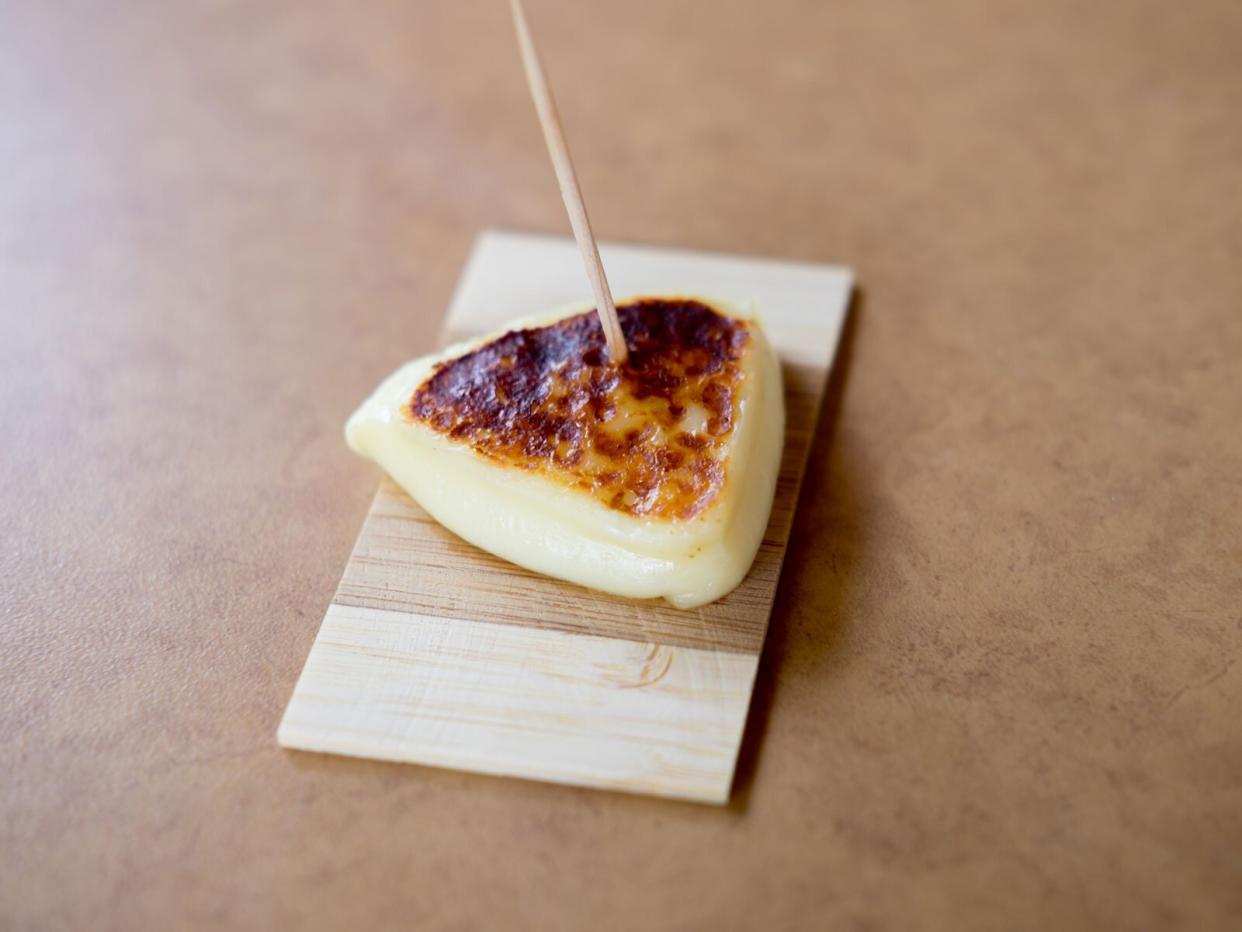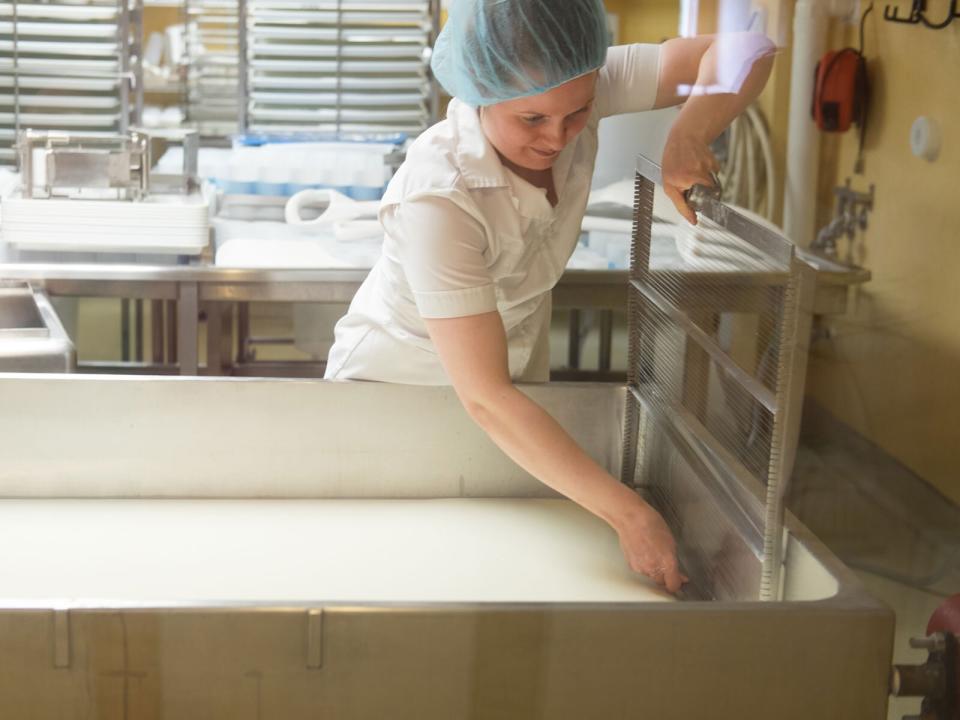Where to Find the Oldest Cheese in North America

Naomi Tomky
When my Quebec City tour guide mentions that the island we're heading to has the oldest cheese in North America, I'm briefly concerned. A grotesque vision of a 150-year-old pickle my friend Harriet once told me about flashes before my eyes. But, what I learn upon arriving at the Île d'Orléans, 15 minutes from the capital, is that Paillasson is simply the oldest style of cheese in North America—it's made fresh on the island, tastes extremely good and nearly disappeared in the '60s.
Grilled until crispy and brown, cut into a wedge and oozing out slowly, the buttery cheese squeaks as I eat it. Les Fromages de l'Isle d'Orléans, the only place currently producing the cheese, teeters between "serious dairy doing historic and amazing cheesemaking" and "hokey tourist attraction." The 17th-century-costumed employees pull themselves back from the brink of embarrassment with charm, a fount of curd knowledge and some spectacular cheese. Reminiscent of halloumi in texture, but with the sweet brightness of fresh milk, Paillason smells vaguely of pancakes hot off the griddle and offers a refreshing salinity.
In the early 17th century, the French explorer Samuel de Champlain brought with him three cattle, the historically-dressed guide explained. "Presumably at least one male," he added, before narrating the history of cheese in the area. Newcomers brought over most of their recipes from the Old World, but—as settlers are wont to do—they adapted their traditional foods to the new environment.
The traditional cheese of the Île d'Orléans bears some resemblance to styles made in France, but the island's cheese has long stood alone. Something set the cheese here apart, observed Pehr Kalm, the Finnish explorer, in the 18th century. What that something was, however, was yet to be discovered.

Naomi Tomky
Historically, every family on the pastoral island made its own cheese, but as the island modernized, fewer and fewer did. "From 1940 to 1970, only 38 families made the cheese," the guide said. As the island grew in the '60s, new families arrived, as did the provincial bureaucracy. New laws included a 1965 provision that limited raw-milk cheese production—which was how, at the time, the traditional cheese was made. If the milk wasn't pasteurized, cheeses had to be aged 60 days, long enough for the island's fresh style to turn to liquid. Most local families stopped making it, leaving it to practically disappear for decades. But one local man, Gerard Aubin, wasn't ready to let tradition slide away.
When the 1965 law passed, Aubin panicked. "Who will save the cheese?" he asked in a newspaper article. He abandoned his commercial cheesemaking, unable to comply with the law, but continued to make it for his own family and friends, while looking for a way to produce the cheese publicly again. After years of frustration, he sought scientific help. In 1993 he hired a microbiologist to investigate the mystery of the glorified cheese of the Île d'Orléans: What made it impossible to replicate in the nearby university lab?
The name Aubin gave his commercial revitalization of the cheese hints at what his team discovered: paillasson translates to "doormat." The reed mat on which the cheese usually dried over wood stoves imparted a specific flavor, drawn from microorganisms unique to that part of the St. Lawrence River where the reeds were collected. The water on the island's north shore becomes salty in the high tide, then dries out in the low tides, when locals could pick the reeds and make the mats. When the cheese dried on the mats, it picked up the local flavor.
A few years after Aubin's experiments began, Jocelyn Labbé, a retired radiologist, bought a plot of land on the island—the foundation of an old hotel that had burned down in 1971. A friend of his, it turns out, has been the researcher working with Aubin on the cheese, and Labbé and Aubin combined forces to start Les Fromages de l'Isle d'Orléans. After four years of battling for permits, devising commercial recipes and building facilities, the current cheese-making facility was completed in 2004, making it the sole producer of the oldest cheese in North America, now christened Paillasson.
In the basement cheese-making facility, a historic stove, metal urns, wooden baskets and a traditional reed mat lie dormant in an alcove. Behind a glass-paneled wall, a hair-netted woman combs curds in an immaculate, modern metal tub filled pasteurized milk. To make the cheese safely and compliantly, the microorganisms from the reeds are steamed onto the cheese instead of connecting directly, while plastic replicas of the mats imprint it with the traditional pattern to create a cheese that looks and tastes like that of the past.
Upstairs in the gift shop, where packs tourists buy from the costumed staff, history seems mined for a show. Down here, in the basement, I sample some of the curds fresh from the vat, and it seems mined for flavor.

